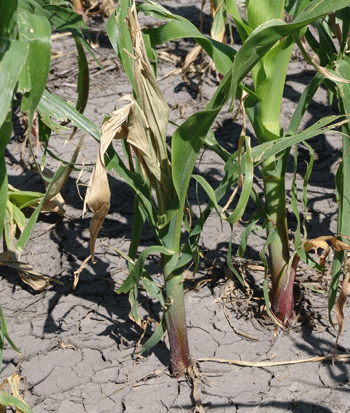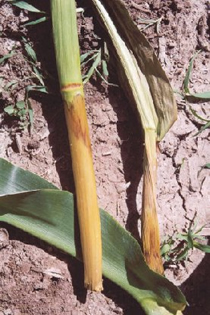Leaf and stalk injury encourages entry of bacteria into the corn plant. Stalk of corn with bacterial stalk rot note the water-soaked brown appearance of the lower stalk.
It can also be spread by water splashing.

Bacterial stalk rot in corn. Zeae is one of the most common causal agent of bacterial stalk rot. Leaf and stalk injury encourages entry of bacteria into the corn plant. Bacterial stalk rot of corn is favored under conditions of high air temperatures and wet weather or high humidity.
Several fungal pathogens cause stalk rots but this season the stalk rots being observed in corn fields are those. Zeae a bacterium that persists on crop residues in soil. Bacterial stalk rots in corn are more commonly reported than are bacterial ear rots.
Bacterial stalk rot of corn is a somewhat unusual disease of corn. Corn stalk with. Bacterial stalk rot is not common but often shows up with overhead irrigation of corn especially where the water source is a lake pond or slow-moving stream.
Plants suddenly lodge and internodes close to the soil line are discolored and water soaked. It is readily capable of establishing and thriving on corn and sorghum plants as it enters natural openings or wounds made from weather or pests. The rot either extended from the base upwards basal rot or from the top downwards top rot.
The causal agent is Gib- berella zeaewhose asexual stage is. The bacterium can infect stalks but is more frequent early in the season when it rots corn leaves in the whorl prior to tassel emergence. Fusarium stalk rot of corn.
Cause Erwinia chrysanthemi pv. Internally the stalk turns into a soft mass of disintegrated tissue. Therefore the best management practices are fall cultivation to incorporate residue a reduction of pathogen and an avoidance of excessive irrigation.
It is among the most common stalk rots in the Midwest with F. Symptoms appear during warm wet. Bacterial stalk rot of corn is favored under conditions of high air temperatures and wet weather or high humidity.
The bacterium causing the disease attacks the plant through natural openings wounds in the leaf whorl stalks and roots caused by insects and injuries brought about by strong winds or mechanical means. Dickeya zeae E. This disease is most common with overhead irrigation where the water source is a lake pond or slow-moving stream.
Bacterial rot Bacterial rot occurs at all stages of crop growth causing top rot stalk rot and ear rot depending upon the tissue or organ affected. Affected plants have shredded pith that may be a. As the main component of corn stalk lignin encapsulates cellulose and hemicellulose Ji 2015.
The disease usually occurs after pollination. Fusarium graminearum a common seedling pathogen of corn and the causal agent of Fusarium head. Bacterial Stalk Rot Although called bacterial stalk rot distinct symptoms of this disease often occur when plants are in the whorl stage.
Verticillioides the primary causal pathogen. Bacterial stalk rot. Field observations made since 1985 suggest that it is causing substantial damage on corn hence given consider able attention.
Under natural conditions the period of microbial degradation of lignin is long and the industrial lignin-degrading bacteria white rot fungus can be produced Arun and. When water containing the bacterium is moved onto corn plants particularly smaller plants in the vegetative stage water containing the bacterium pools in the whorl and leaf sheaths and has easy access to natural openings or wounds on the corn plant. This disease is most common with overhead irrigation where the water source is a lake pond or slow-moving stream.
Bacterial stalk rot can survive in corn or sorghum stalks and residue is a sporadic disease and often affects individual plants. Gibberella stalk rot is distributed worldwide and is one of the most common stalk rots in the Corn Belt. Corn stalk rots are mainly caused by fungal pathogens though bacterial infections and insect injury can also lead to stalk rot development.
When overhead irrigation is used a top rot can follow quickly during times of fast vegetative growth. Fusarium stalk rot is caused by multiple fungal pathogens in the Fusarium genus. There is very limited host tolerance to soft rot bacteria.
Then localized outbreaks of the disease can occur. Stalk ots Bacterial Stalk Rot Bacterial stalk rot caused by the bacterium Erwinia chrysanthemi pv. Bacterial stalk rot as the name implies is caused by a bacterium that grows well on wet decaying plant material.
Tissues are degraded by soft rot bacteria creating infections that are slimy masses of decomposed corn tissue with a distinct foul odor. The bacterial stalk rot pathogen is a soft-rot bacterium that produces enzymes to degrade host tissues resulting in slimy smelly mushy masses of rotted host tissues Figure 4. Often developing under warm humid conditions or in conjunction with.
Bacterial stalk rot is not common but often shows up with overhead irrigation of corn especially where the water source is a lake pond or slow-moving stream. Then localized outbreaks of the disease can occur. In the case of basal rot the leaves become yellow and the infected tissue becomes brown soft and water soaked.
Several seasons may pass without the disease showing up at all. Zeae is typically only a problem in irrigated fields particularly seed corn fields. Bacterial stalk rot is caused by strains of Erwinia carotovora.
The disease usually starts mid-season. Bacterial stalk rot is not common but often shows up with overhead irrigation of corn especially where the water source is a lake pond or slow-moving stream. Unlike many of the fungal stalk rots bacterial stalk rot can occur very early in the season.
Several seasons may pass without the disease showing up at all. Bacterial stalk rot of corn is favored under conditions of high air temperatures and wet weather or high humidity. Bacterial stalk rot of corn is a somewhat unusual disease of corn.

More Bacterial Diseases In Corn Goss S Wilt And Bacterial Stalk Rot Confirmed Cropwatch University Of Nebraska Lincoln

Bacterial Stalk Rot Of Maize Pests Diseases

Bacterial Stalk Rot In Sweet Corn Weekly Crop Update

Bacterial Stalk Rot In Corn Weekly Crop Update

